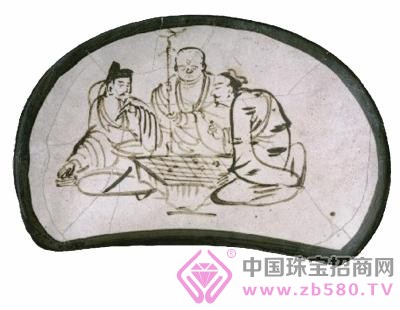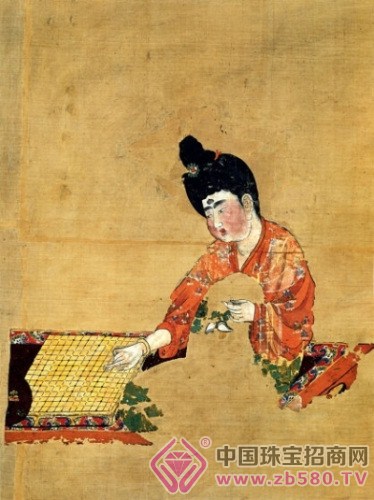
Jin Dading, 18 years, Cizhou kiln porcelain pillow
Recently, the Korean Go game world champion Li Shishi and Google's artificial intelligence Go software Alpha dog battle is fiercely unusual. The PK between the "human representative" and the intelligent robot has caused countless attention.
As we all know, Go originated in China. What is the history of this ancient intellectual game? Today, we will interpret it from the perspective of archaeological collections.
1. Lost handbooks
Jin Yong wrote in the novel "Swordsman" that the Japanese and Japanese gods left to ask Heaven to save the teacher, and to lure the four friends of Jiangnan and Linghu to compare the sword. The bait that he throws to the "chess" black and white is A game of Go that has been lost - "Blood Blood Spectrum", it is said that this is a game played by Liu Zhongkai, a great national hand in the Northern Song Dynasty.
It is not known whether there is a "hematemesis spectrum" in the world. So far, the oldest ancient chess game in the world is the Dunhuang "Chess Classic". The Dunhuang "Chess Classic" was discovered in the Dunhuang Grottoes in 1899. It was written in the back of a scroll of Buddhist scriptures. The first volume has been broken, and the coexistence of 2,443 characters. The author is unknown. The era is estimated to be the Northern Zhou Dynasty of the Northern and Southern Dynasties. The "Chess Classic" text is simple, and it introduces the historical facts of the military and the predecessors, and clarifies the strategy of playing chess. It is written in the volume of "black son" as "Wu Zi", according to the scholar Mr. Cheng Enyuan, because the North Zhou Yuwen Taidi small word "black scorpion", in order to avoid the shackles and "black" writing "black." It is a pity that the Dunhuang "Chess Classic" was robbed by the Stein to the United Kingdom along with a large number of Buddhist scriptures, and the existing British Museum.
The earliest existing chess scripture in China is the collection of 13 pieces of the "Chess Classic" in Song Ben's "Forgetting Worry and Clear Music Collection" edited by Li Yimin in the Southern Song Dynasty. The book was written in the Northern Song Dynasty. At least 200 years later than Dunhuang's "Chess Classic" - this shows the preciousness of Dunhuang's "Chess Classic".
2. Go board and Shouling people
The earliest go-go board found in China is the Han Dynasty pottery chess board discovered by archaeologists in the excavation of the Nanmen Gate site in Hanyang, Shaanxi. Its unearthed proves that the Chinese people more than 2,000 years ago have begun to travel in the "black and white world."
Hanyang Mausoleum is the burial cemetery of Emperor Han Jingdi and the emperor of the fourth generation of the Western Han Dynasty. The Nantunmen ruins are located 120 meters south of the Mausoleum. The chessboard unearthed here is slightly damaged and has an irregular pentagonal shape with a residual length of 28.5 cm to 5.7 cm, a width of 19.7 cm to 17 cm, and a thickness of 3.6 cm. Both sides of the board are inscribed in straight lines, with 17 vertical and horizontal lines, which are basically similar to the modern Go board.
Li Gang, an assistant researcher at the Shaanxi Provincial Institute of Archaeology, who participated in the excavation work, said that from the texture of the ceramic chessboard, it was made of a piece of paving bricks at that time, and the lines of the vertical and horizontal lines of the disk were sketched and rough. This shows that although the chessboard was unearthed in the Royal Cemetery, it is obviously not a royal thing. It is probably the memorial of the Hanling Mausoleum, which is used for entertainment in leisure time.
It is inferred that in the Western Han Dynasty more than 2,000 years ago, Go was not only a game of the aristocratic class, but also popular among civilians like the cemetery guards.
3 is not just black and white
In recent years, many ancient ruins and tombs have been discovered one by one. People have smashed the pieces of the earth into pieces, which has become the new favorite of collecting investment. The textures, shapes, and times of these chess pieces are different, telling us about the history of the development of ancient Chinese Go.
In 1968, a pair of agates were unearthed in a tomb of the Liao Dynasty in Chaoyang City, Liaoning Province, with 186 capsules each. The tomb owner lived in the period of Liao Shizong, Liao Jingzong, and Liao Shengzong, and served as the judge of the Bazhou State. Level cadres. The number of chess pieces shows that the level of Go is very high at that time. In the 1970s, a site of the Yuan Dynasty courtyard was discovered in Houyingfang, Xizhimen, Beijing. A pair of chess pieces were unearthed on the floor tiles of the main courtyard. There were 121 red fruits, which were ground with red agate and 101 white. Agate is ground. According to research, these artifacts may be left by Zhu Yuanzhang’s general Xu Dawei when he was besieged in Beijing. Around 2003, in the municipal reconstruction project at the entrance of Beijing Niujie Post Office, a pair of Jindai porcelain double-sided carved double-phoenix-shaped chess pieces were unearthed. This is the most common collection of public and private collections and ancient pieces in various places. A beautiful pair. Among them, there are about 120 black pieces and about 130 white pieces. The pieces are 1.8 cm in diameter and 0.4 cm in thickness. The double phoenix is ​​double-sided and the surface is shiny. It should be a lacquer process. More than 200 pieces are made. It is unparalleled in the world.

The Tang Dynasty "Guru's Lady Figure" painting, unearthed in 1972 in Astana, Turpan
4 wonderful game in the portrait
The Go game originated in the Heluo area. In the Luoyang Go Museum, an Eastern Han Dynasty chess portrait stone attracts attention. It depicts a pattern consisting of houses, figures, carriages, safari birds and cattle. Two people sit opposite each other, wearing a girder with a front ridge, a wide-brimmed sleeve, a square chessboard in the middle, and a round chess piece in the dish. visible. The two hands raised their hands and smiled, seeming to signal the opponent to play first. This portrait stone is a concrete reflection of the popular Go culture in ancient China. It has obvious characteristics of the times and provides valuable material information for studying the profound Go culture of ancient China.
The Gossip paintings unearthed in the tomb of Xizhou in the Tang Dynasty reflect the high development of Go culture in the Sui and Tang Dynasties. The chessboard was broken when it was unearthed, but the main theme of the whole picture can still be seen: the two women in the center of the picture are the girls and waiters who come to watch the game. This is a tomb of the Tang Dynasty, reflecting the scene of aristocratic women's spring entertainment, which was particularly popular in Chang'an in the Tang Dynasty. In order to popularize Go activities among women, the Tang Dynasty was responsible for teaching the palace people to play chess. The poet Du Fu’s wife is well versed in the game, and Du Fu has sent a sensation and wrote the record of “Wife paints the chess gameâ€. When Tang Xuanzong’s first-class national chess player waited for Wang’s salary, he had benefited from the guidance of the two village women in Suizhong, and he was invincible from then on. These two village women can dictate chess, that is, our "blind chess" in the modern sense, it can be seen that the level of Go in the Tang Dynasty has reached a very high level.
Millinery Church Hats,Silk Couture Hats,Satin Dress Hats,Women'S Dress Hats
SHAOXING YONGJING FASHION HATS & ACCESSORY CO.,LTD. , https://www.yongjingchurchhat.com